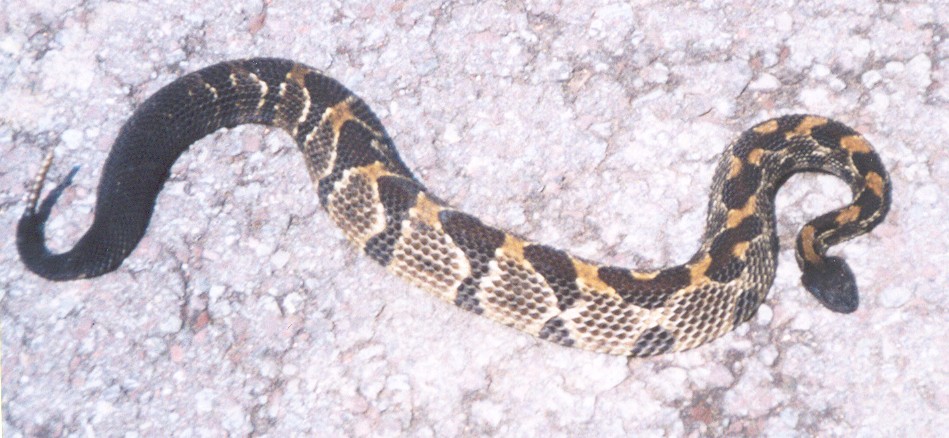Pike County Federation of Sportsmen's Clubs
Timber Rattlesnake
Crotalus horridus

The timber rattlesnake is the more common of two poisonous snakes found in Pike County. In fact, Pike County is so famous for its rattlesnakes that a common saying in Harrisburg used to be, "There is nothing in Pike County but Rocks, Republicans, and Rattlesnakes".
Timber rattlesnakes are in the pit viper family. They prey mainly on small mammals, but may also consume birds, amphibians, and other snakes using their venom to immobilize their meal. In most cases the venom kills the animal immediately. When it doesn't, the snake will slowly follow its victim until it drops.
Timber rattlesnakes are large, stout, snakes. They average about three feet long and may reach five feet or more. Compared to other snakes, the body is very thick. It has a large triangle shaped head and a rattle on its tail. The color can vary from yellow and brown to almost completely black. Sometimes both color phases will be found on the same snake. It is a common misconception that a rattlesnake's age can be determined by counting the number of segments on the rattle. A single button will be found on a "new born" snake. Afterwards, a new segment will be added every time it sheds its skin which it may do more than once a year. Furthermore, as the snake advances in age, it is common for the end segments to break off leaving a less than complete rattle.
Timber rattlesnakes are long-lived, but slow to mature sexually. Males usually mature in five years - females in eight. They produce small litters of between five and ten. The snakes mate in the late summer/early fall and the young are "born" the following September. Unlike most snakes, rattlesnakes do not lay eggs. The fertilized eggs remain in the mother until mature. As the mature eggs are expelled from the female, they spontaneously hatch giving the appearance of live birth.
When alarmed, the rattlesnake will rapidly shake its namesake tail. The noise is not so much a rattle, but instead sounds more like the buzz of an electric alarm clock. Because it is needed to secure food, the rattlesnake will often not inject its venom when striking in self defense. However, there is no way to know in advance if the snake will inject its venom or not. Therefore, bites must be avoided at all costs and all bites must be considered as potentially fatal.
Timber rattlesnakes den together in large numbers. The same den is often used for decades and the loss of the den may result in the death of many snakes. Rattlesnakes caught and relocated from their home area have been known to die of exposure trying to find their dens.
Humans needlessly killing rattlesnakes, low birth rates, and loss of dens have all contributed to a decline in rattlesnake numbers. Rattlesnakes are a protected species in Pennsylvania. They should not be killed except as permitted by law.
IMPORTANT INFORMATION
From "birth" rattlesnakes carry enough venom to kill a person. Never handle any rattlesnake.
Rattlesnakes can strike up to 2/3rds their body length. Do not get close to a rattlesnake.
Rattlesnakes will strike without warning - especially if stepped upon!
If bitten by a rattlesnake, get to a hospital immediately! Do not attempt to suck out the poison. Do not give the victim alcohol.
Rattlesnakes are often hard to see. You might walk right by one without even noticing it. You might even step one one you didn't see. Be careful out there !
PCFSC Home Page Observing Nature Home Page